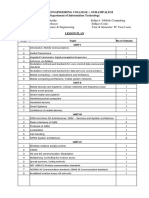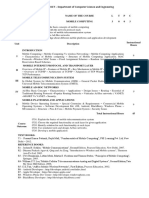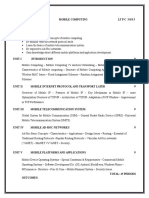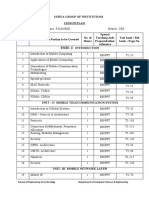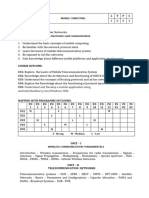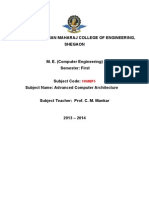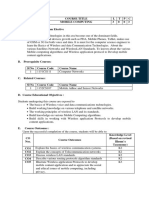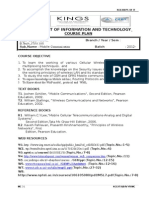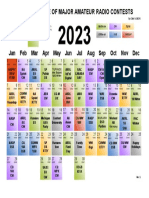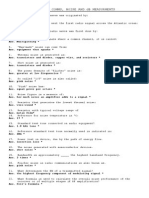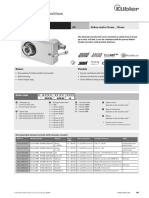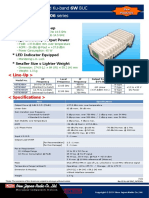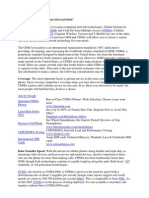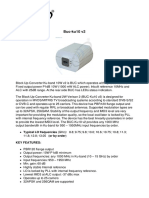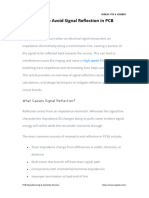CHRISTU JYOTI INSTITUTE OF TECHNOLOGY & SCIENCE
DEPARTMENT
OF
COMPUTER SCIENCE & ENGINEERING
LESSON PLAN
Academic Year : 2017-2018 Year: III B Tech CSE2 Semester-II
Name of the Faculty : Pranay Kumar BV Designation: Associate Professor
Name of the subject: Mobile Computing Subject code:CS611PE
Number of periods/week :6 Theory :4 Tutorial:1 Remedial class/week : 1
B.Tech. III Year II Sem. L/T/P/C
Course Code:CS611PE 3/0/0/3
Course Objectives:
To make the student understand the concept of mobile computing para-
digm, its novel applications and limitations.
To understand the typical mobile networking infrastructure through a popu-
lar GSM protocol
To understand the issues and solutions of various layers of mobile networks,
namely MAC layer, Network Layer & Transport Layer
To understand the database issues in mobile environments & data delivery
models.
To understand the ad hoc networks and related concepts.
To understand the platforms and protocols used in mobile environment.
Course Outcomes:
Able to think and develop new mobile application.
Able to take any new technical issue related to this new paradigm and come
up with a solution(s).
Able to develop new ad hoc network applications and/or algorithms/proto-
cols.
Able to understand & develop any existing or new protocol related to mo-
bile environment
1
�UNIT – I: Introduction: Mobile Communications, Mobile Computing – Para-
digm, Promises/Novel Applications and Impediments and Architecture; Mobile
and Handheld Devices, Limitations of Mobile and Handheld Devices. GSM – Ser-
vices, System Architecture, Radio Interfaces, Protocols, Localization, Call-
ing, Handover, Security, New Data Services, GPRS, CSHSD, DECT.
UNIT – II: (Wireless) Medium Access Control (MAC): Motivation for a spe-
cialized MAC (Hidden and exposed terminals, Near and far terminals), SDMA,
FDMA, TDMA, CDMA, Wireless LAN/(IEEE 802.11) Mobile Network Layer: IP and
Mobile IP Network Layers, Packet Delivery and Handover Management, Loca-
tion Management, Registration, Tunneling and Encapsulation, Route Optimiza-
tion, DHCP.
UNIT – III: Mobile Transport Layer: Conventional TCP/IP Protocols, Indirect
TCP, Snooping TCP, Mobile TCP, Other Transport Layer Protocols for Mobile Net-
works. Database Issues: Database Hoarding & Caching Techniques, Client-
Server Computing & Adaptation, Transactional Models, Query processing, Data
Recovery Process & QoS Issues.
UNIT – IV: Data Dissemination and Synchronization: Communications
Asymmetry, Classification of Data Delivery Mechanisms, Data Dissemination,
Broadcast Models, Selective Tuning and Indexing Methods, Data Synchroniza-
tion – Introduction, Software, and Protocols.
UNIT – V: Mobile Adhoc Networks (MANETs): Introduction, Applications &
Challenges of a MANET, Routing, Classification of Routing Algorithms, Algo-
rithms such as DSR, AODV, DSDV, etc. , Mobile Agents, Service Discovery. Pro-
tocols and Platforms for Mobile Computing: WAP, Bluetooth, XML, J2ME,
Java Card, Palm OS, Windows CE, Symbian OS, Linux for Mobile Devices, An-
droid.
TEXT BOOKS:
Jochen Schiller, “Mobile Communications”, Addison-Wesley, Second Edition,
2009.
Raj Kamal, “Mobile Computing”, Oxford University Press, 2007, ISBN:
0195686772.
REFERENCE BOOKS:
Jochen Schiller, “Mobile Communications”, Addison-Wesley, Second Edition,
2004.
Stojmenovic and Cacute, “Handbook of Wireless Networks and Mobile Com-
puting”, Wiley, 2002, ISBN 0471419028.
Reza Behravanfar, “Mobile Computing Principles: Designing and Develop-
ing Mobile Applications with UML and XML”, ISBN: 0521817331, Cam-
bridge University Press, Oct 2004
S.NO Topic (JNTU syllabus) Books/journal No. of Syllabus to
references with
2
� page numbers classes be
planned completed
by date
UNIT I MC Introduction
1 Mobile Communications, Mobile 1
2 Computing – Paradigm, 2
3 Promises/Novel Applications and 1
4 Impediments and Architecture; 1
5 Mobile and Handheld Devices, 1
6 Limitations of Mobile and Hand- 1
7 held Devices. GSM – Services, 2
8 System Architecture, Radio Inter- 3 4-01-2019
faces, Protocols, Localization,
Calling, Handover, Security, New
Data Services, GPRS, CSHSD,
DECT.
UNIT II Wireless MAC
9 Motivation for a specialized MAC T1 (83-88),
2
(Hidden and exposed terminals, R4(63-66)
10 Near and far terminals), SDMA, T1 (90-101) 2
11 FDMA, TDMA, CDMA, T1 (126-129) 1
12 Wireless LAN/(IEEE T1 (131-145) 2
13 802.11) Mobile Network Layer: IP T1 (154-164)
and Mobile IP Network Layers, 25-01-2019
Packet Delivery and
Handover Management, Location 2
Management, Registration,
Tunneling and Encapsulation,
Route Optimization, DHCP.
14 Tutorial 3
UNIT III Mobile Transport Layer
15 Conventional TCP/IP Protocols, T1 ( 169-179), 1
Indirect TCP, Snooping TCP, Mo- R4(101-110)
16 bile TCP, Other Transport Layer T1 (181-191) 1
17 Protocols for Mobile Net- T1 (205-215) 2
18 works. Database Issues: Database T1 (219-228) 2 19-02-2019
Hoarding & Caching Techniques,
Client-Server Computing & Adap-
19 T1 (229-236) 1
tation, Transactional Models,
20 T1 (237-251) 2
Query processing, Data Recovery
28-2-2019
Process & QoS Issues.
21 Tutorial 3
UNIT IV Data Dissemination and Synchronization
22 Communications Asymmetry, T1 (255-269) 2
23 Classification of Data Delivery T1 (274-280) 1
24 Mechanisms, Data Dissemination, T1 (281-291) 2 22-03-2019
25 Broadcast Models, Selective Tun- T1 (316-328) 2
26 ing and Indexing Methods, Data T1 (329-334) 2
Synchronization – Introduction,
Software, and Protocols.
27 Tutorial 3
3
� UNIT V MANETs
28 Introduction, Applications & T1 (368-372) 1
29 Challenges of a MANET, Routing, T1 (373-381) 2
30 Classification of Routing T1 ( 383-390) 2
31 Algorithms, Algorithms such as T1 (392-397) 2
32 DSR, AODV, DSDV, etc. , Mobile T1 (414-426) 2
Agents, Service
Discovery. Protocols and 11-04-2019
Platforms for Mobile Computing:
WAP, Bluetooth, XML, J2ME,
Java Card, Palm OS, Windows CE,
Symbian OS, Linux for Mobile
Devices, Android.
33 Tutorial 3
Faculty Signature HOD Signature








